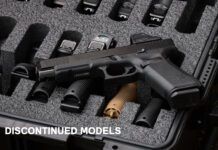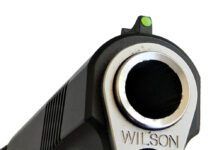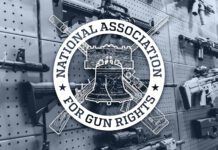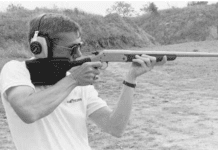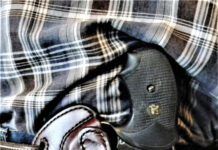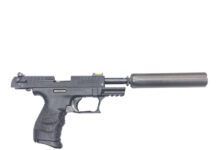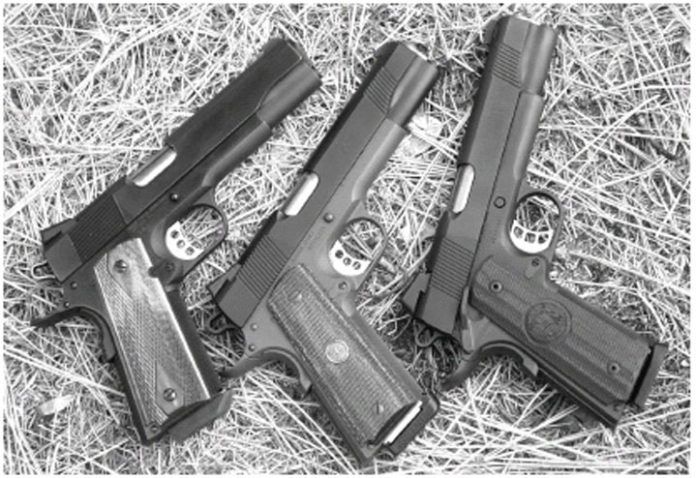How much should you spend on a “perfect” handgun? How much should you spend for anything that is generally considered to be at the very top of its field? A Ferrari F60 will set you back half a million bucks, give or take a few hundred thousand, and a new Purdey shotgun today lists at around $85,000. But how much ought you to spend for a really good 1911 .45 auto, when your lifes on the line and money is no object? Were leaving engraving out of the picture entirely in this discussion, though many will want it on their ultimate handguns. Its possible to acquire a thoroughly reliable 1911 for well under a grand, but it may not satisfy you completely over time, for one reason or another, especially if you have lots of experience with the type. It might not be completely dehorned, or its finish may not be all that durable, or itll need a trigger job or better accuracy, or whatever. All these things can be fixed, but all cost time and money. How about if you spend around two grand?
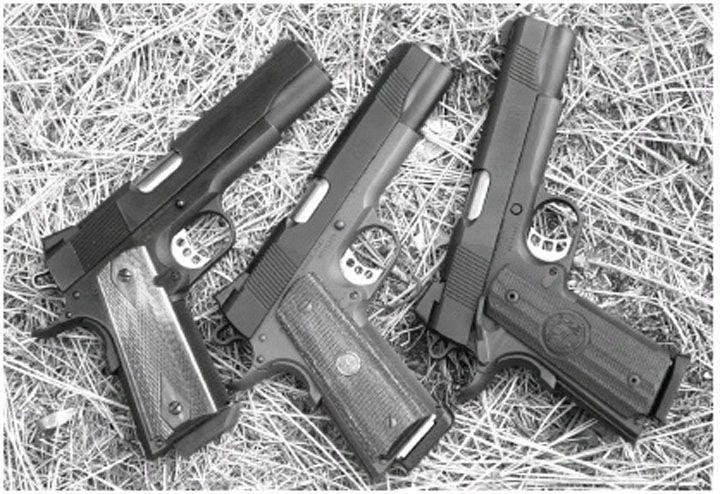
For that kind of money, it seems to us, you ought to get a gun that needs exactly nothing. It ought to work every time for many thousands of rounds, with zero failures of any sort. It ought to outlive you, all your grandchildren, and then some. It should have a decent trigger pull. The finish, whatever it is, ought to be durable. There are plenty of excellent finishes available today that are in fact really durable, and you should not have to pay extra for that. Nor do we believe such a handgun should show any appreciable wear from several years spent in a holster. The gun should be fully dehorned so you can practice clearance drills, or go through any training center in the country – or the world – without the gun ripping up your hands. The sights may or may not be adjustable, but these top-notch guns probably ought to have tritium sights, unless you specifically dont want them. If the sights are adjustable they must never break, and thats a tall order. If the sights are not adjustable, they should be capable of being regulated to your favorite load. The gun should at least hit mighty close to center when you get it. The grips and the front and rear straps should have decent traction, but not too much of it until you grab it hard.
The gun ought to be able to feed, fire, and eject any reasonable self-defense loads (we assume these are self-defense guns). It is unrealistic to expect the gun to print to the same impact point with light 185-grain target loads or with 165-grain JHPs as it does with 230-grain ball, so that means either the gun should have adjustable sights or, more important, the shooter needs to know what load he or she will use in it. If you get our drift, were assuming such a handgun will probably not be the best choice for the inexperienced shooter. To justify such a costly handgun, the shooter, we think, should have put in his time with a 1911 and ought to know what features he wants on his gun, and should have a good idea of the type of ammunition to be used.
The individual may want some special features, such as a lanyard ring or maybe a special grip material, checkering pattern, etc. Also, were talking a full-size 1911 in this evaluation. Lighter or smaller 1911 types are generally preferable for long-term concealed carry, but many shooters are mighty happy with the full-size gun and dont want – or are not allowed – anything smaller.
What we like may not be what you like, but remember the test crew for these 1911s has many years and hundreds of thousands of rounds experience with the type. The three we looked at were the Rock River Pro Carry ($1795), Wilson Combat CQB ($2150), and Nighthawk GRP ($2695 as tested). We tested them with five types of ammo. Black Hills remanufactured hardball, Federals Hi-Shok JHP in both 185 and 230 weights, with Winchester 185-grain BEB truncated cone, and with sizzling Cor-Bon 185 JHP. Well jump ahead here and let you know there were zero failures of any kind with the three guns.
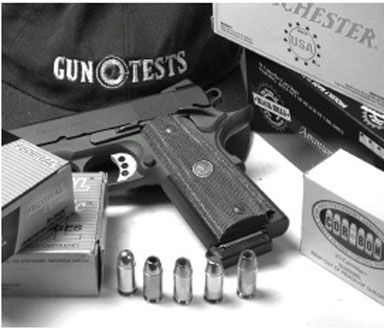
All three were very tightly fitted, yet none needed a “break-in” period before we could operate them in all their functions by hand. All had beavertails with bumps, skeleton hammers, lightened aluminum triggers of the Videki type, and grip safeties that worked without needing recontouring, as we found with the S&W. All had straight mainspring housings of steel, and checkering on front and rear grip surfaces. Two guns had forward slide serrations for the new-type press checking, but all three could be press checked the old way, with a careful pinch. All had tritium sight inserts, but one of the setups was superior. All three had decent triggers, but only two were perfect. They all had relieved mag-well openings to aid fast reloads, and all had pads on the magazines. They all had dovetailed front sights with the protrusions rounded to blend with the slide. One final observation that applied to all three is that they were very well fitted between slide and frame, with no observable movement. Lets see what else we found out.
Rock River Pro Carry
.45 ACP, $1795
The gun came in a hard-plastic case with foam padding. There was one obvious “fault” with this gun right off the bat. It was blued, and we all know bluing shows wear quickly, whether from rough hands or from holster wear. Our beloved Valtro shows signs of its having been carried a lot, and after only a few years it looks like an old gun. So will the Rock River after a few months of constant use. Rock River offers an alternate finish called “Black T,” but there is no price information about it on the very-AR-15-oriented website (www.rockriverarms.com). A minor complaint will not apply to over-the-counter buyers of this handgun, but our Rock River arrived in three pieces, the slide and barrel packaged separately, and there was no bushing wrench included to put it together. We used our own wrench to turn the very tight bushing.
Once the gun was assembled, it looked great. The bluing was shiny on the sides of the slide and frame, and matted on the remainder, and the workmanship was excellent throughout. The front strap and flat mainspring housing had fine checkering at 25 lines per inch that was beautifully done. The website gave the option of choosing 20-, 25-, or 30-lpi checkering. We noted the checkering covered more of the front strap than with either of the other two guns. You can also specify an arched mainspring housing if you prefer. The “Super rosewood” grips had reasonable checkering that permitted us to steer our hand into place, and then when we gripped the gun, the checkered steel held it exactly where we wanted it.
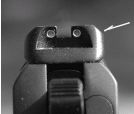
The Pro Carry had a Kart barrel. Like all three guns it was ported and ramped with care. The overall appearance of the gun was understated, with obviously precise fitting and great manufacturing care taken throughout. Rock River offers a few more choices, including Heinie or Novak rear sights, both with tritium inserts. Ours was a Novak. The gun came with only one magazine, and it held but seven rounds. Oddly, the website guaranteed 2.5-inch accuracy at 50 yards with match ammo, but thats not the ammo most would choose for a “carry” gun. But we got about 3-inch groups with hardball at that range in informal tests, so we have no problem with that claim. As discussed elsewhere, the accuracy of each of the three guns in this report is all anyone would ever need.
The trigger broke consistently at just over 4 pounds, despite the online claim of 3.5. This was the heaviest pull – though it did not feel so on the range – of the group. Accuracy was, like the others, good enough to put five shots with the right ammo through one ragged hole at 15 yards. Bullets struck exactly where aimed at that range. We noted a slight tendency to vertically string the shots, but in general they were all usually touching.
Nighthawk GRP .45 ACP, $2695
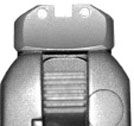
GRP stands for Global Response Pistol, and the extras on this example ran its cost up considerably. The bare-bones gun cost only $2195. We took the only GRP that was available, but would have saved lots of money if we had had time to order it to our specifications. The extras include $350 for the amazing matte-black Black Diamond finish, $65 for an ambi safety (Wilsons charge $35), and $80 for the serrations in the slide top. We tried to mar the Black Diamond finish in a hidden corner of the gun with our pocket knife, but could not do so. This, we think, is what a pistol finish ought to be. We put the Robar Companys highly corrosion-resistant NP3 finish in the same league, from previous experience, and there are others that might serve as well. There is a page full of custom upgrades at the company website (www.nighthawkcustom.com). You can choose from several finish and detail options, or different sights if desired, but you can expect to pay for any deviance from the basic gun. For example, if you dont want forward slide serrations, add (dont subtract!) $50. If you order either Black Diamond or hard-chrome finishes, expect to wait at least six weeks extra.
The gun had great smoothness right out of the box. We liked the look of the grips, and the finely checkered front and back straps. We could well have done without the extra-cost ambi safety. Unique among this trio, there was a provision for a lanyard loop at the bottom of the mainspring housing. Working the slide to clear the gun was an exercise in how a 1911 ought to feel. The effort to cock the hammer during this operation was quite low and very smooth. But in fairness, the other two were about equally slick. We liked the Nighthawk so far, but were just getting started with our examination. The sights had tritium inserts and – alone of the trio – the rear sight was adjustable. The rear sight was by Novak and had tall ears on both sides, and had a big screw on top for elevation adjustment. There was a tiny, hidden Allen screw to lock the windage. So the gun could be made to print on center. We had some doubts about those tall ears, though, and wondered how they might contribute to snagging.
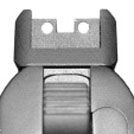
Like the Wilson CQB, the Nighthawk came in a padded, zippered, carry case with plenty of pockets inside, and with two eight-round magazines. These Novak mags didnt have the Black Diamond finish, but instead were highly polished and blued. Frankly, for the cost of the finish, that seemed odd to us. A test target came with the gun. The target had three holes, one from each of three types of ammo, fired from 15 yards. They cut one jagged hole on the paper, but we would have preferred to see more holes of one type. Our testing did verify that all three guns printed to nearly the same point with all ammo tested, at 15 yards.
The GRP had extra-cost longitudinal serrations on top of the slide to cut any glare. We could have done without them. The gun had metal grip panels, machine carved with an attractive serrated pattern. We liked the look but they added weight, and in the fast-shooting tests we thought they didnt work as well as checkered wood. The trigger was slightly loose in its track, moving up and down noticeably, unlike the other two. It did give the occasional very slight bit of creep, which we didnt get from the other two guns. The pull was just under 4 pounds.
On the range, several faults became obvious with the Nighthawk. To a man, we all thought the rear sight presented a cluttered image to the shooter that took valuable time away from target acquisition. We appreciated the fact that the sights were adjustable. However, of all three test guns, the Nighthawk was the only one that required any adjustment to its sighting. It was not zeroed as it came to us. It shot over a foot high at 50 yards, and about six inches left. The other two guns, with fixed sights, were right on the money.
Next, we found too many sharp edges on the Nighthawk. One was on the edge of the safety, where some of us rest our strong-hand thumb. The edge of the slide stop had a sharp corner that we again found to be painful. These edges cut our thumbs, which never ought to happen. Remember, this gun had that nice-looking, expensive, protective finish. If you file off the razor edges, youre left with bare steel on a $2700 handgun. Also there was a sharp edge next to the ejection port, which the Rock River also had, that could gouge the hand in a clearance drill. And the front edge of the adjustable rear sight was also a hand gouger. Wed replace that rear sight with a fixed one that would be both faster and smoother, but would probably cost more.
The next bone of contention with our experienced 1911 shooters was the grip surface. We found the excellent traction given by the neat grips and perfectly checkered steel was too sticky for most of us. The mainspring housing was checkered at 20 lines per inch, and it was 22 lpi on the front strap. Some of our problems seemed to come from the grip-panel finish. We found it difficult to slide the hand into the correct position once initial contact was made anywhere on the grips. The ideal 1911 grip must be slippery at first, so the shooting hand can slide into the correct position. There are several ways to accomplish this. One of the best ways is to use Kim Ahrends clever Tactical grips with checkering that leaves the rear portion of the wood grips smooth, yet when you grab the gun the checkering locks the fingers where they want to be. Another trick is to use finer steel checkering. Whatever the reason, the Nighthawks grips didnt completely please our test crew, though the workmanship was generally excellent and the overall appearance was great.
Wilson Combat CQB
No. WCQB-T-A .45 ACP, $2150
Bill Wilson spent many years in active practical-shooting competition, and along the way he learned a whole lot about what a decent, self-defense-oriented, no-nonsense 1911 ought to have and ought not to have. That is probably the reason the CQB just blew us all away. Everything about this handgun was close to perfect. It defined what a self-defense 1911 ought to be. Everyone who handled the three, including relative novices to the game, said that the CQB felt the best, had the most pleasant grip, the easiest-seen sights, and felt lighter than the others, too.
The CQB had an olive-drab green frame and dull black slide, both Wilsons durable and slick “Armor-Tuff” finish. You dont get a lot of options with the CQB other than your choice of ambi (for $35 more) or single-side safety, the latter being our choice and what this one had. You do have a choice of green/black like our test gun, or gray/black, or all black. Checkering on front and rear was 30 lpi, which most of our shooters liked best of the trio. The grip panels were black checkered diamond wood. The sights were absolute perfection, the sight picture being instantly seen with no distractions whatsoever. The tritium inserts were yellow on the back, with brighter green on the front sight, and we liked this setup more than the all-green of the other two. There was noticeably less confusion with this setup for really fast sight acquisition in dim light.
Unlike the other two guns, there were exactly no sharp edges on the Wilson that could gouge the hands. The ejection port was rounded off suitably everywhere, and clearance drills – which require you to rake your hand violently rearward along the top of the slide to rip off stovepipe jams – could be done all day without harm to the weak hand. Clearly, Mr. Wilson understands this very well.
If we could nit-pick the CQB at all it would be for the protruding slide-stop axle on the right side. If you lay your right index finger against it and put pressure on it and then work the slide, its possible to push the slide stop part of the way out, which ties up the slide. The Rock River had the same problem. Cutting the axle to zero protrusion, such as is done by Valtro and Nighthawk, would cure this. However, takedown of the gun without any tools becomes more difficult with a shorter axle.
We found the surface finish of the Wilson to be the slickest in our leather holsters. We tried two holsters for this test and they both gave strong indications that the Wilson finish was slickest, the Rock River finish was okay, but the Nighthawk Black Diamond finish was sticky against leather. That might be a good thing, of course, and your holster may give different results. We noticed some drag with the Nighthawk with our Bachman Slide, and we had the devil of a time getting the GRP into and out of a Sparks Summer Special. The others slid in and out easily, which we preferred.
Overall workmanship on the CQB was on a par with the other two guns. We all liked the look of the green frame and black slide. On the range we found the CQBs accuracy to be about equal to the others. All three handguns tried the abilities of our test crew to make groups as well as each gun could shoot. Our overall consensus was that the Nighthawk was perhaps the most accurate, and the CQB and Rock River were about tied. It is probable that groups as large as three inches at 15 yards would be adequate for self-defense use, but more accuracy is always better, given perfect functioning. All three of these guns had one-hole capability at 15 yards with at least some of the ammo we tried.
More to the point was how well the three guns compared, rapid fire. To find out, we shot many fast pairs starting from the holster. We also shot many fast presentations with only a single shot fired. Not to our surprise, the Wilson CQB beat the other two guns easily for speed and accuracy. The sights were by far the easiest to see, and gave the fastest, cleanest sight picture. The grip was the fastest for our hands to grasp properly, and the trigger pull was also the best and lightest, at 3.5 pounds absolutely clean.
Gun Tests Recommends
Rock River Pro Carry .45 ACP, $1795. Conditional Buy
We did find some flaws with the Pro Carry. The outer edges of the rear sight were rounded, and tended to catch light reflections that slowed down our rapid-fire shooting. The bright highlights tended to pull the eye away from the front sight and made finding the top of the front sight harder and slower than it should have been. Yet this sight picture was cleaner and faster than that of the Nighthawk. One other slight flaw bears mention. The right-rear edge of the ejection port could gouge the hand during clearance drills. The rest of the gun was plenty slick, and very much to our liking. Except for its quick-wearing blued finish, only one seven-shot mag, and that glaring rear sight, this gun was okay for us. The trigger could have been lighter but it was okay, and very clean. Wed be happier paying a bit more and getting a really good finish and two eight-round magazines.Nighthawk GRP .45 ACP, $2695. Dont Buy.
We did love the accuracy of the Nighthawk. It seemed to be the finest of the trio, though not by a whole lot. The worst accuracy of the test trio was way more than enough for self-defense shooting. Workmanship of the Nighthawk was outstanding, for the most par, but it was also the heaviest of the trio, and by far the most costly. We all noticed the extra weight, even novices, and the GRP didnt seem as lively to us as a result. We liked the cut-off slide stop on the right side of the frame, which weve seen previously only on the Valtro. Our favorite aspect of the Nighthawk was its extra-cost finish. The gun, like all three, functioned perfectly but the sharp edges, atrocious rear sight picture, too-sticky grips and extra weight were not to our liking. We would not buy it as long as either of the others were available, even without the extra-cost options. You might just love it. We didnt.Wilson Combat CQB No. WCQB-T-A .45 AP, $2150. Our Pick.
Bottom line, if our life was on the line and we had to pick one of these three fine 1911s to defend it, we would choose the Wilson Combat CQB. It did it all with great finesse, and left the other two in its shadow. Practical experience apparently counts for a lot, and Bill Wilsons competition experience has produced a gun good enough for him – or us – to carry as a first-line defender. We think most shooters having long experience with the 1911 will agree with us. The CQB has it all. It has way more than adequate accuracy, perfect balance, an ideal trigger pull, fast sights that were easily seen in broad daylight or down a dark alley, a good-looking finish that is durable, and great workmanship throughout. We liked it a lot. GT
Written and photographed by Ray Ordorica, using evaluations from Gun Tests team testers.


